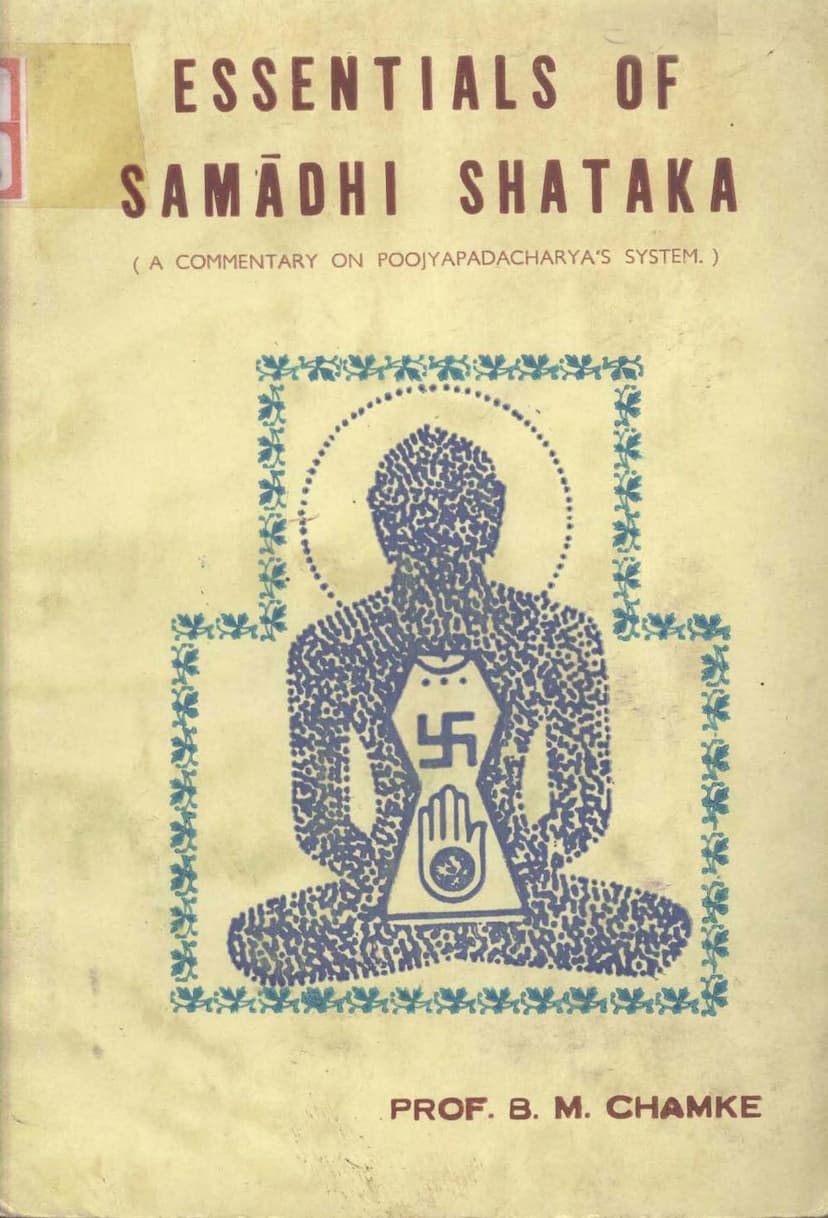Essentials Of Samadhishataka
Added to library: September 1, 2025

Summary
Here's a comprehensive summary of "Essentials of Samadhishataka" by Prof. B. M. Chamke, based on the provided text:
Book Overview:
"Essentials of Samadhishataka" is a commentary and interpretation of Pujyapada Acharya's "Samadhishataka" (sometimes referred to as Jain Gita). Prof. B. M. Chamke, a distinguished scholar and professor of philosophy, aims to elucidate the profound teachings of Pujyapada, making them accessible to a wider audience. The book focuses on the Jain philosophical concept of the soul and its journey towards liberation (Moksha).
Author and Context:
- Prof. B. M. Chamke: A well-respected philosopher with extensive teaching experience, holding prominent positions in academic bodies. He is known for his scholarly contributions to philosophy and Jainism.
- Pujyapada Acharya: A revered Jain philosopher, grammarian, and poet. He was originally from a Brahmin background and later embraced Jainism. His works, including "Samadhishataka," are considered significant contributions to Jain philosophy.
- Samadhishataka: A work consisting of 100 to 105 verses that delves into the nature of the soul and the path to self-realization and ultimate bliss. The book's original name is commonly accepted as "Samadhishataka."
Core Philosophical Concepts and Themes:
The central theme of "Essentials of Samadhishataka" revolves around the tripartite classification of the soul and the journey of realizing the ultimate spiritual state.
-
The Tripartite Soul: Pujyapada Acharya, as interpreted by Prof. Chamke, divides the soul into three states:
- Bahiratma (External Soul): This is the soul that is identified with the material body, senses, and worldly attachments. It is characterized by ignorance, delusion, and sensual desires, which are considered impediments to spiritual progress. This state is to be repelled and subdued.
- Antaratma (Internal Soul): This is an intermediate stage where the soul begins to realize its true nature, distinguishing itself from the material world. It involves subduing passions and adhering to ethical and religious principles. The Antaratma serves as a means to reach the highest state.
- Paramatma (Supreme Soul): This is the ultimate state of liberation, characterized by eternal bliss, omniscience, and absolute consciousness. It is the self-luminous, pure, and perfect state of existence, the ultimate goal (Moksha or Nirvana).
-
The Path to Liberation (Moksha): The book details the journey from the Bahiratma to the Paramatma. This involves:
- Discrimination (Viveka): The crucial step of differentiating between the soul (Jiva) and non-soul (Ajiva), the spiritual and the material.
- Ethical Conduct and Spiritual Discipline: Adherence to Jain principles like Right Faith (Samyag-darshana), Right Knowledge (Samyag-jnana), and Right Conduct (Samyag-charitra) are essential. This includes austerity, restraint, and control over passions.
- Abandoning the External (Bahiratma): Actively rejecting worldly temptations, sensual desires, and identification with the physical body.
- Cultivating the Internal (Antaratma): Developing inner strength, self-awareness, and a focus on the spiritual nature of the self.
- Meditation and Contemplation (Samadhi): Deep concentration and contemplation on the soul are presented as the direct means to realize the Paramatma. This involves "seedless Samadhi" (Nirvikalp Samadhi).
-
Nature of the Soul:
- The soul is described as self-luminous, eternal, pure, conscious, and of the nature of bliss (Ananda).
- It is beyond sensory perception and can only be realized through self-experience and direct apprehension by the heart.
- The soul is not subject to limitations of sex, gender, age, or physical form.
-
Misconceptions and Ignorance: The book highlights how ignorance (Avidya) leads to the soul's misidentification with the body, resulting in suffering (Samsar). This includes:
- Believing the body is the self.
- Misunderstanding relationships (wife, son, etc.) as extensions of the self.
- The cyclical nature of birth and death driven by karmic impressions.
-
The Importance of Faith and Knowledge:
- Faith is presented as the foundation for spiritual progress, guiding thought and action.
- True knowledge is not merely intellectual but experiential, leading to liberation.
- The text criticizes views that suggest liberation is easily attained or that penance alone, without proper insight, is sufficient.
-
Critique of Other Philosophical Views: The book briefly touches upon refuting the materialistic views of Charvaka and the self-sufficiency of the soul in Samkhya, asserting the necessity of diligent spiritual practice.
-
The Author's Contribution: Prof. Chamke's work is praised for its clarity, critical analysis, and its ability to unravel the subtle points of Pujyapada's teachings. It is seen as a valuable "Bhashya" (commentary) that makes this treasure of Indian thought accessible to the common person. The book also attempts to establish the ancient roots of Jainism by referencing its mention in Vedic texts.
Key Takeaways:
- The journey to spiritual liberation is an internal one, achieved through self-awareness, ethical living, and deep contemplation.
- The material world and the body are transient and ultimately unreal in comparison to the eternal nature of the soul.
- Ignorance is the primary cause of suffering, while true knowledge and self-realization lead to ultimate bliss and freedom.
- Pujyapada Acharya's "Samadhishataka" provides a profound roadmap for this spiritual ascent, focusing on the purification and elevation of the soul.
In essence, "Essentials of Samadhishataka" offers a detailed and insightful exploration of the Jain path to self-realization, emphasizing the transformative power of understanding the soul's true nature and diligently following the spiritual disciplines prescribed by Pujyapada Acharya.